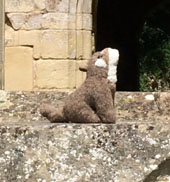
Titchmarsh Castle
Minster Lovell Hall
Other Lovell Castles
Francis, Viscount Lovell and Sir Thomas Lovell
Old Wardour Castle, which is now in the care of English Heritage, was the second of the Lovells' main residences that I visited. Like my trip to Titchmarsh Castle (or more correctly the place where that castle once stood) it was not until years after I had finished my thesis that I finally visited it (2005). Again, many years later (June 2017), I visited the ruins again. Sadly this stay was by far not as long as I had hoped, since my way there was prolonged excessively by getting lost in the woods, the satnav having never heard of the place, and a fallen tree blocking the road.
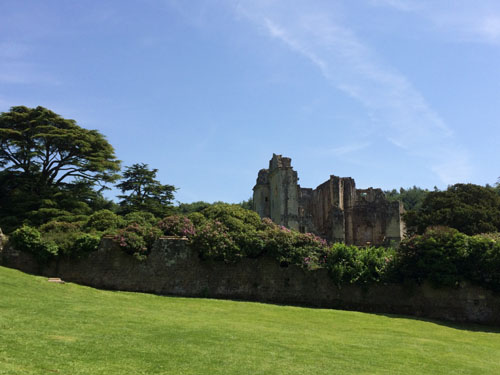
Old Wardour Castle
Wardour had once been the property of the Kings of Wessex, and, around the year 900, Alfred the Great gave judgement in the chamber there. Some sort of manor must have therefore existed at Wardour since that time, but where it was, how large it was and where it was situated is unknown. When John Lovell acquired Wardour, he decided to rebuilt it on a grand scale and in 1393 received the necessary 'licence to crennelate'.

Front of Wardour Castle
John Lovell was also determined to create something spectacular and unusual. Though tower houses are far from unusual, Wardour Castle with its hexagonal shape is quite unique. (The Yellow Tower of Gwent at Raglan Castle were built later.) In their search for what may have inspired John Lovell or his architect to choose this unusual design researchers have looked as far away as Castel del Monte in southern Italy, Bellver on Mallorca or the Château de Concressault (Département of Cher). Closer to home was Queenborough Castle in Kent, that Edward III had built between 1361 and 1377. As John Lovell was at this time involved in the royal administration, it is possible that he may have actually seen the castle himself accompanying Edward III on one of his inspections there.
Like the Château de Concressault, Wardour is hexagonal in shape, like Queenborough Castle (which had a circular plan) the surrounding walls echo that of the castle. What is different are the two projecting towers creating a distinctive 'front' at Wardour castle.

Enlarged and false windows added by Sir Matthew Arundel
It says a lot about John Lovell that he had decided to built on such a grand scale. The construction must have been very expensive. Considering that he did not spend much time at Wardour, as for a significant part of his time he was at court or on campaign, the function of the castle as a symbol of his power was at least as much on his mind as its use as a comfortable country retreat. It is also interesting that John Lovell's descendants soon lost interest in Wardour. His grandson William Lovell apparently preferred to live at Minster Lovell, where he oversaw a major rebuilding programme. William Lovell's son, another John Lovell, lost possession of the Wardour Castle for having fought on the Lancastrian side in the opening stage of the Wars of the Roses and, unlike the majority of his estates, Wardour Castle was not returned to his possession.

One of the shell-headed seats added by Sir Matthew Arundel
In the latter half of the sixteenth century, Sir Matthew Arundel ordered major improvements on the by now rather old-fashioned building. The windows were enlarged and a number of blind windows added to increase the symmetry of the facade. Fashionable architectural details were added and the interior improved and sumptuously furnished.[4]

Renaissance portal, another addition by Sir Matthew Arundel
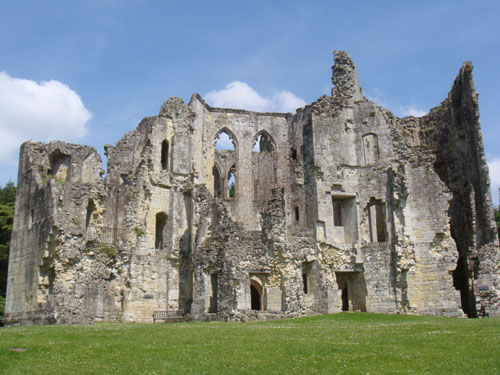
The castle's heavily damaged side
The royalist Lord Henry Arundel, who had succeeded his father as owner of Wardour Castle shortly before, naturally wanted to regain possession of it. This second siege lasted even longer, from December 1643 to March 1644. When the parliamentarian garrison inside the castle were already hard pressed and short of food, one of the mines was accidentally set off and large sections of the walls were destroyed. The garrison finally surrendered. Though Henry Arundel had thus regained possession of the castle, it was now uninhabitable.
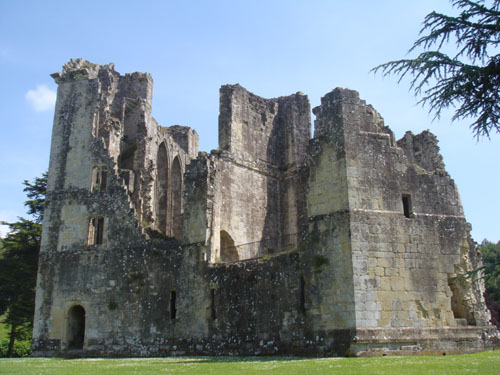
More heavy damage to the castle's walls
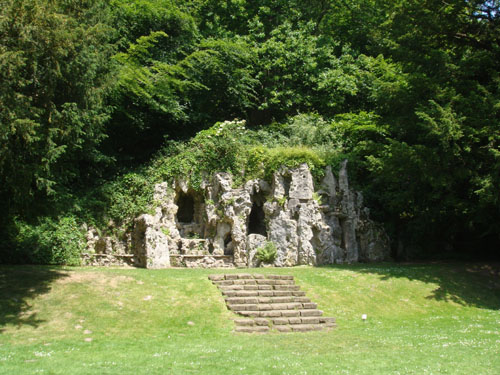
The artificial grotto added to make the ruins even more romantic
They ruins of Old Wardour Castle were used as the set of the destroyed home of the Earl of Locksley in Robin Hood: Prince of Thieves. - Unfortunately the entire castle is seen only at night in the film, and during the shot of the front Kevin Costner is blocking most of the view. The grotto, on the other hand, can be seen very clearly. Morgan Freeman and Walter Sparrow carefully keep to the side.
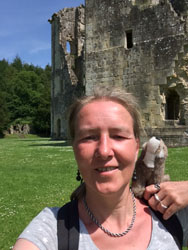
Kate II and I on our memorable trip to Old Wardour Castle, 14 June 2017
[1] Roskell, J.S., Clark, Linda S. and Rawcliffe, Carole (eds.), The House of Commons, 1386-1421, 4 vols. (Stroud, 1993), vol. iv, p. 114
According to the Victoria County History, John Lovell's sister Elizabeth was married to Robert of London. Robert's sister Maud in turn, was married to Robert of Ramsbury. Her granddaughter (of no name) was married to Thomas Calston, VCH, Wiltshire, vol. xii, p. 49.
[2] Mark Girouard, ‘Wardour Old Castle – I’, in Country Life (Feb 14, 1991), p. 44.
[3] Magdalen College, Oxford, Adds. 99. (Lovell Papers)
[4] An inventory of the furnishings exists from 1605, Brian K. Davison, Old Wardour Castle (English Heritage Guidebook, 1999), p. 28.
[5] R.B. Pugh and A.D. Saunders, Old Wardour Castle (London, 2nd ed., 1991), p 19.
Laurence Keen, ‘Excavations at Old Wardour Castle, Wiltshire’, Wiltshire Archaeoloical Magazine 62 (1967), 67-78.
W. Mark Ormrod, Edward III (2011, paperback 2013).
R.B. Pugh and A.D. Saunders, Old Wardour Castle (London, 1968).
Simon, M.E., 'The Lovells of Titchmarsh. A Late Medieval Baronial Family (1297-148?)', (unpubl. DPhil Thesis, University of York, 1999).